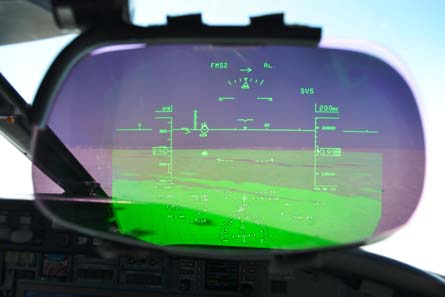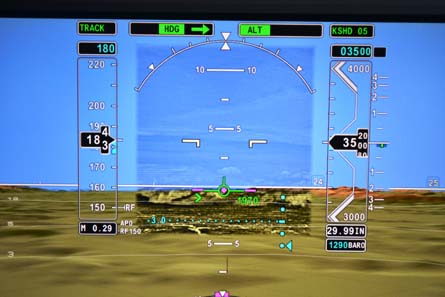Honeywell has fired a retaliatory shot at avionics rival Rockwell Collins in a marketing battle over who has the edge in next-generation visual landing aids - Honeywell's head-down display (HDD) aids or Rockwell Collins' head-up display (HUD) tools.
Both companies are seeking progressively more landing "credit", or lowered instrument approach minimums, using a synthetic vision system (SVS) alone or combined with other inputs such as forward-looking infrared (IR).
Rockwell Collins in April revealed that internal testing on a Bombardier Global Express 5000 aircraft had demonstrated a substantial increase in flight path control accuracy when pilots use synthetic vision (SV) on a HUD to fly an instrument approach versus traditional heads-down non-SVS guidance. While acknowledging that "tracking on the HDD with SV also showed improvement when compared to the HDD without SV", the company also maintains that using a HUD avoids "the difficult head-down to head-up transition prior to decision height" when a pilot must use natural vision to press on for landing. Rockwell Collins, the largest provider of HUDs to the industry by virtue of its acquisition of Flight Dynamics in 1999, is convinced that HUD technologies are the future.
 |
|---|
| © John Croft/Flightglobal Rockwell Collins found head-up displays offer a substantial increase in flightpath control accuracy |
Based on a series of flight tests over Honeywell in August, however, revealed that pilots "highly experienced" with HUDs "performed equally well" with its head-down technology demonstrator "after limited introduction", bringing into question the difficulty of the eyes-in to eyes-out transition at decision height.
HEADS DOWN AT HONEYWELL
Honeywell's approach would save operators from having to purchase HUDs, but questions remain as to whether an HDD could be considered an equivalent "sensor" to a HUD, regardless of the sensor input. To get landing credit today, an operator must use an approved enhanced flight vision system (EFVS), which includes a HUD, a cooled IR sensor and special flight-crew training and procedures. Credit is a factor-of-two reduction in decision height (DH), from 200ft down to 100ft for a straight-in Category 1 approach. Honeywell currently does not have an in-house HUD manufacturing capability, although it continues to support several models with which it has been involved.
On a 19 August flight, the company demonstrated to Flight International an experimental version of its heads-down combined vision system (CVS), a technology that joins synthetic vision (an image based on 3D terrain and obstruction data) with enhanced vision (a forward-looking IR image). The primary flight display in this case has many of the same indications found on an EFVS HUD, such as acceleration and velocity cues, runway symbols and an expanded pitch scale.
A prime goal of Honeywell's research was to show that an HDD could give pilots the same benefits as a HUD when it came to identifying a runway and landing at the conclusion of an instrument approach to 100ft. The aircraft was Honeywell's experimental Gulfstream 450 (N922H), equipped with a Kollsman EVS 1 cooled IR sensor and modified avionics, with combined vision option front and centre on the pilot's primary flight display. The HDD versus HUD comparisons can be made because the aircraft and the pilots are approved for enhanced flight vision system (EFVS) instrument approaches to 100ft with the onboard Honeywell 2020 HUD.
Honeywell considers the project to be at technology readiness level five (TRL 5), with more pilot assessment data and fine tuning of the concept still to come in order to reach TRL 6, the point in the development cycle when a new Honeywell SmartView product could be launched, pending a "go" from the company.
A significant amount of research and human factors work has gone into the combined vision system to date. Results of the initial study, a September 2009 low-fidelity simulator survey comparing HUD to HDD using eight pilots with HUD experience, were encouraging. "One conclusion was that the HDD could be equivalent to the HUD if the contrasting [on the display] was correct," says human factors expert Trish Ververs, Honeywell's enhanced and synthetic vision project lead. "Pilots initially couldn't see the runway approach lights in the IR window due to other information on the [display]."
 |
|---|
| © John Croft/Flightglobal CVS technology combines synthetic vision with infrared-based enhanced vision |
During follow-on tests in June and October 2010 with four Honeywell flight test pilots and one customer pilot flying the company's Kollman EVS II-equipped Cessna Sovereign, Ververs says there were a lot of "aha!" discoveries. Engineers had decluttered the primary flight display (PFD), splitting the pitch reference "ladder", fading the runway centreline and making other mid-course adjustments when pilots lower the landing gear on approach. The changes in effect opened up the IR window so pilots could better see the actual approach lights on the PFD, a necessary ingredient to continue the approach down to 100ft.
Further refinements were evaluated in a battery of Gulfstream 450 fight tests in December 2010, which were followed by more Sovereign tests in May 2011.
Along the way, Honeywell has progressively tuned the look and feel of synthetic vision on the PFD and the IR box inside the display. The IR box was initially "big and monochromatic green", says Ververs, but pilots found it obtrusive - the image was dark and drew attention away from other details on the PFD. Instead, the preference was to have the IR box similar in colour to the actual background. "That was a revelation," says Ververs. Honeywell modified the box to be 70% translucent over the synthetic vision background above the zero pitch line and opaque IR below that line. There's also a weather mode and taxi mode that makes the entire IR box fully opaque.
Since a PFD is relatively small compared to the actual scene it represents (not conformal), compression of the synthetic vision scene is a critical factor in how the pilot perceives motion and situational awareness. While NASA and others had tested variable compression ratios based on the phase of flight (closer to 1:1 near landing), Honeywell found that a constant ratio of 2.2-2.6:1 is best. The next phase of testing designed to get the technology closer to TRL 6 will be done in a G450 simulator with 10 airline and business jet pilots flying the G450 with CVS "in controlled conditions", says Ververs.
VISIONS OF THE FUTURE
During the 19 August flight, I flew in the left seat during EFVS and CVS approaches to compare the two. Although I do not normally fly business jets and am not approved for EFVS operations, I did find the CVS to be intuitive and transitioning to visual flight from the head-down display to the outside world a simple task in daylight visual weather.
While landing credit below a 100ft decision height is likely to require multiple independent sensor technologies for safety, Rockwell Collins, like Honeywell, believes that some credit for a lower landing minimum can be had for synthetic vision alone. Like Honeywell, the company is part of an international (RTCA/Eurocae) effort working to come up with standards for progressively lower landing minimums using various technologies and processes.
RTCA special committee 213 (SC-213), which develops the performance and operational specifications the US Federal Aviation Administration generally adopts for EFVS rules, is also drafting performance specifications for how operators might gain landing credit for SVS alone. "From all the simulation studies that NASA has done, in addition to [avionics manufacturers'] flight testing, we have quite a bit of data that shows we can do that with synthetic vision systems," says Tim Etherington, principal systems engineer at Rockwell Collins. The idea at the start is to decrease the DH to 150ft, and then eventually lower. In parallel, RTCA and its European counterpart, Eurocae working group 79, are developing the requirements for reducing the DH for EFVS progressively down to the runway elevation.
 |
|---|
| © John Croft/Flightglobal Honeywell has progressively fine-tuned the look and feel of synthetic vision |
"We talked to [the FAA] a number of times about what is the mechanism for getting credit for SVS," says Etherington. "The climate within FAA was that changing regulations was not going to be in the industry's best interest - it would take too long. They encouraged us to look at other methods." One good candidate might be a modification to FAA order 8400.13, which covers special authorisations for Category 1 instrument approaches.
Meanwhile, Etherington says the FAA has started "some activities" towards gathering more data and is looking for a customer to "do an analysis as part of the first certification". Rockwell Collins is likely to be that customer, as the company has committed to being the first to gain certification and approval for SV-only landing credit.
For Honeywell, the larger battle will be in proving out that HDD is an equivalent display to a HUD when seeking approval for SVS-only landing credit, or the more rigorous EFVS landing credit, potentially down to runway altitude and zero visibility. Ververs says some early feedback from the FAA was positive.
On 19 August, the company also flew some special guests in the Cessna Sovereign demonstrator with CVS - the FAA. "Before the flight, they all were worried about the transition," says Ververs. "After, all were believers."
- Read Flight's test pilot Peter Collins' flight-test report on the Dassault Falcon 7X EVS/HUD
Source: Flight International



















